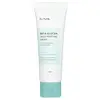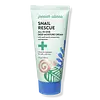What's inside
What's inside
 Key Ingredients
Key Ingredients

 Benefits
Benefits

 Concerns
Concerns

 Ingredients Side-by-side
Ingredients Side-by-side

Water
Skin ConditioningButylene Glycol
HumectantGlycerin
HumectantMethyl Trimethicone
Skin ConditioningCentella Asiatica Extract
CleansingBeta-Glucan
Skin ConditioningCetearyl Alcohol
Emollient1,2-Hexanediol
Skin ConditioningNiacinamide
SmoothingHydrogenated Polyisobutene
EmollientIsononyl Isononanoate
EmollientCetearyl Glucoside
EmulsifyingGlyceryl Stearate
EmollientSorbitan Stearate
EmulsifyingCetearyl Olivate
Sorbitan Olivate
EmulsifyingAcrylates/C10-30 Alkyl Acrylate Crosspolymer
Emulsion StabilisingBetaine
HumectantAllantoin
Skin ConditioningAdenosine
Skin ConditioningDipotassium Glycyrrhizate
HumectantGlucose
HumectantSodium Hyaluronate
HumectantArginine
MaskingPrunus Salicina Fruit Extract
AntioxidantPunica Granatum Fruit Extract
AntioxidantRubus Idaeus Fruit Extract
AstringentFragaria Vesca Fruit Extract
AstringentPrunus Persica Fruit Extract
AbrasiveWater, Butylene Glycol, Glycerin, Methyl Trimethicone, Centella Asiatica Extract, Beta-Glucan, Cetearyl Alcohol, 1,2-Hexanediol, Niacinamide, Hydrogenated Polyisobutene, Isononyl Isononanoate, Cetearyl Glucoside, Glyceryl Stearate, Sorbitan Stearate, Cetearyl Olivate, Sorbitan Olivate, Acrylates/C10-30 Alkyl Acrylate Crosspolymer, Betaine, Allantoin, Adenosine, Dipotassium Glycyrrhizate, Glucose, Sodium Hyaluronate, Arginine, Prunus Salicina Fruit Extract, Punica Granatum Fruit Extract, Rubus Idaeus Fruit Extract, Fragaria Vesca Fruit Extract, Prunus Persica Fruit Extract
Snail Secretion Filtrate
Skin ConditioningWater
Skin ConditioningHydrogenated Polydecene
EmollientGlycerin
HumectantCetearyl Olivate
Propanediol
SolventButyrospermum Parkii Butter
Skin ConditioningJojoba Esters
EmollientHyaluronic Acid
HumectantHydrolyzed Hyaluronic Acid
HumectantSodium Hyaluronate
HumectantCetearyl Alcohol
EmollientCentella Asiatica Extract
CleansingCentella Asiatica Leaf Extract
Skin ConditioningCentella Asiatica Root Extract
Skin ConditioningAsiatic Acid
Skin ConditioningAsiaticoside
AntioxidantMadecassic Acid
Skin ConditioningMadecassoside
AntioxidantBetula Alba Juice
AstringentSqualane
EmollientSorbitan Olivate
EmulsifyingGlyceryl Stearate
EmollientButylene Glycol
HumectantCarbomer
Emulsion StabilisingHydroxyethylcellulose
Emulsion StabilisingPhytosteryl Macadamiate
Skin ConditioningTocopherol
AntioxidantEthylhexylglycerin
Skin Conditioning1,2-Hexanediol
Skin ConditioningHydrolyzed Malt Extract
Skin ConditioningTrisodium Ethylenediamine Disuccinate
Sorbitan Isostearate
EmulsifyingC18-36 Acid Triglyceride
EmollientTromethamine
BufferingHydroxyethyl Acrylate/Sodium Acryloyldimethyl Taurate Copolymer
Emulsion StabilisingGlycyrrhiza Glabra Root Extract
BleachingSynthetic Beeswax
Emulsion StabilisingHydrolyzed Viola Tricolor Extract
Skin ProtectingHydrolyzed Gardenia Florida Extract
AntioxidantC12-18 Acid Triglyceride
EmollientPhytosterols
Skin ConditioningPinus Pinaster Bark Extract
AntioxidantBiosaccharide Gum-1
HumectantSnail Secretion Filtrate, Water, Hydrogenated Polydecene, Glycerin, Cetearyl Olivate, Propanediol, Butyrospermum Parkii Butter, Jojoba Esters, Hyaluronic Acid, Hydrolyzed Hyaluronic Acid, Sodium Hyaluronate, Cetearyl Alcohol, Centella Asiatica Extract, Centella Asiatica Leaf Extract, Centella Asiatica Root Extract, Asiatic Acid, Asiaticoside, Madecassic Acid, Madecassoside, Betula Alba Juice, Squalane, Sorbitan Olivate, Glyceryl Stearate, Butylene Glycol, Carbomer, Hydroxyethylcellulose, Phytosteryl Macadamiate, Tocopherol, Ethylhexylglycerin, 1,2-Hexanediol, Hydrolyzed Malt Extract, Trisodium Ethylenediamine Disuccinate, Sorbitan Isostearate, C18-36 Acid Triglyceride, Tromethamine, Hydroxyethyl Acrylate/Sodium Acryloyldimethyl Taurate Copolymer, Glycyrrhiza Glabra Root Extract, Synthetic Beeswax, Hydrolyzed Viola Tricolor Extract, Hydrolyzed Gardenia Florida Extract, C12-18 Acid Triglyceride, Phytosterols, Pinus Pinaster Bark Extract, Biosaccharide Gum-1
 Reviews
Reviews

Ingredients Explained
These ingredients are found in both products.
Ingredients higher up in an ingredient list are typically present in a larger amount.
1,2-Hexanediol is a synthetic liquid and another multi-functional powerhouse.
It is a:
- Humectant, drawing moisture into the skin
- Emollient, helping to soften skin
- Solvent, dispersing and stabilizing formulas
- Preservative booster, enhancing the antimicrobial activity of other preservatives
Butylene Glycol (or BG) is used within cosmetic products for a few different reasons:
Overall, Butylene Glycol is a safe and well-rounded ingredient that works well with other ingredients.
Though this ingredient works well with most skin types, some people with sensitive skin may experience a reaction such as allergic rashes, closed comedones, or itchiness.
Learn more about Butylene GlycolCentella Asiatica Extract (Centella) is derived from an herb native to Southeast Asia. It is famous for its anti-inflammatory and soothing properties.
Centella is rich in antioxidants and amino acids, such as Madecassic Acid and Asiaticoside.
Studies show the compounds in centella help with:
The combination of all these properties makes centella effective at soothing, hydrating, and protecting the skin.
Other great components of centella include Vitamin A, vitamin C, several B vitamins, and Asiatic Acid.
Fun fact: Centella has been used as a medicine and in food for many centuries. As a medicine, it is used to treat burns, scratches, and wounds.
Learn more about Centella Asiatica ExtractCetearyl alcohol is a mixture of two fatty alcohols: cetyl alcohol and stearyl alcohol. It is mainly used as an emulsifier. Emulsifiers help prevent the separation of oils and products. Due to its composition, it can also be used to thicken a product or help create foam.
Cetearyl alcohol is an emollient. Emollients help soothe and hydrate the skin by trapping moisture.
Studies show Cetearyl alcohol is non-toxic and non-irritating. The FDA allows products labeled "alcohol-free" to have fatty alcohols.
This ingredient is usually derived from plant oils such as palm, vegetable, or coconut oils. There is debate on whether this ingredient will cause acne.
Due to the fatty acid base, this ingredient may not be Malassezia folliculitis safe.
Learn more about Cetearyl AlcoholCetearyl Olivate is an emulsifier and texture enhancer. It is derived from the fatty acids of olive oil and Cetearyl alcohol, and is biodegradable.
As an emulsifier, it is used to prevent oils and waters from separating. It can also
Manufacturers use the name Olivem 1000. This ingredient has been found to preserve the natural microbiome of skin. Having a healthy microbiome helps keep our skin healthy and protects against harmful bacteria. This ingredient is grouped with Sorbitan Olivate under the name Olivem 1000.
Learn more about Cetearyl OlivateGlycerin is already naturally found in your skin. It helps moisturize and protect your skin.
A study from 2016 found glycerin to be more effective as a humectant than AHAs and hyaluronic acid.
As a humectant, it helps the skin stay hydrated by pulling moisture to your skin. The low molecular weight of glycerin allows it to pull moisture into the deeper layers of your skin.
Hydrated skin improves your skin barrier; Your skin barrier helps protect against irritants and bacteria.
Glycerin has also been found to have antimicrobial and antiviral properties. Due to these properties, glycerin is often used in wound and burn treatments.
In cosmetics, glycerin is usually derived from plants such as soybean or palm. However, it can also be sourced from animals, such as tallow or animal fat.
This ingredient is organic, colorless, odorless, and non-toxic.
Glycerin is the name for this ingredient in American English. British English uses Glycerol/Glycerine.
Learn more about GlycerinGlyceryl Stearate is a mix of glycerin and stearic acid.
It is used to stabilize the mixing of water and oil ingredients. By preventing these ingredients from separating, it can help elongate shelf life. It can also help thicken the product's texture.
As an emollient, it helps soften skin and supports barrier-replenishing ingredients.
In cosmetics, Glyceryl Stearate is often made from vegetable oils or synthetically produced.
This ingredient may not be fungal-acne safe
Fun fact: The human body also creates Glyceryl Stearate naturally.
Learn more about Glyceryl StearateSodium Hyaluronate is hyaluronic acid's salt form. It is commonly derived from the sodium salt of hyaluronic acid.
Like hyaluronic acid, it is great at holding water and acts as a humectant. This makes it a great skin hydrating ingredient.
Sodium Hyaluronate is naturally occurring in our bodies and is mostly found in eye fluid and joints.
These are some other common types of Hyaluronic Acid:
Learn more about Sodium HyaluronateSorbitan Olivate is created from the fatty acids in olive oil and sorbitol.
This ingredient is an oil in water emulsifier. It helps stabilize a product by preventing oils and waters from separating. Sorbitan Olivate also helps hydrate the skin.
Manufacturers sell sorbitan olivate under the name OliveM 1000. OliveM 1000 a multifunctional ingredient. It is self-emulsifying. According to a manufacturer, OliveM 1000 does not disrupt natural skin biome.
Due to its olive oil base, this ingredient may not be fungal-acne safe.
Learn more about Sorbitan OlivateWater. It's the most common cosmetic ingredient of all. You'll usually see it at the top of ingredient lists, meaning that it makes up the largest part of the product.
So why is it so popular? Water most often acts as a solvent - this means that it helps dissolve other ingredients into the formulation.
You'll also recognize water as that liquid we all need to stay alive. If you see this, drink a glass of water. Stay hydrated!
Learn more about Water